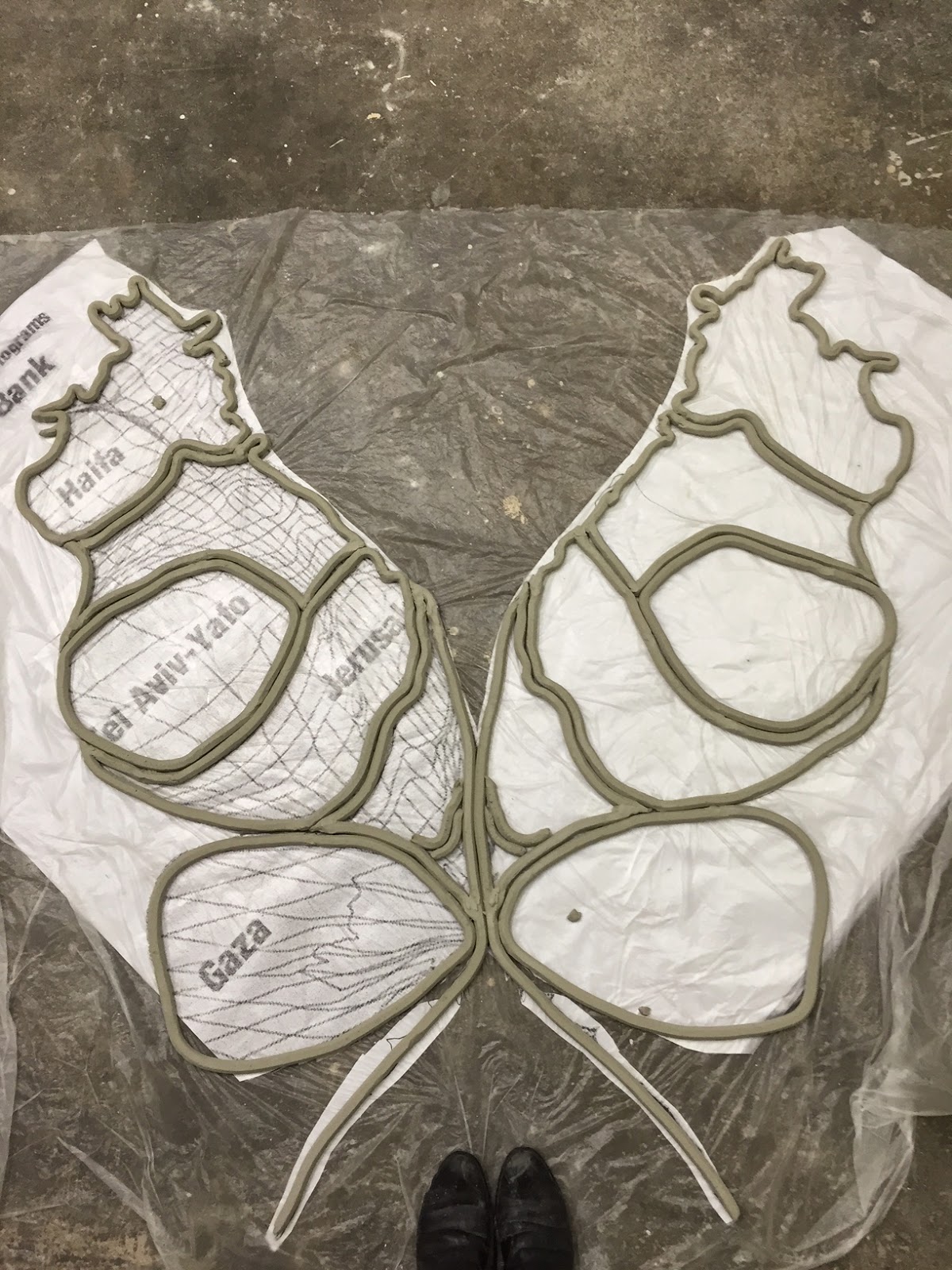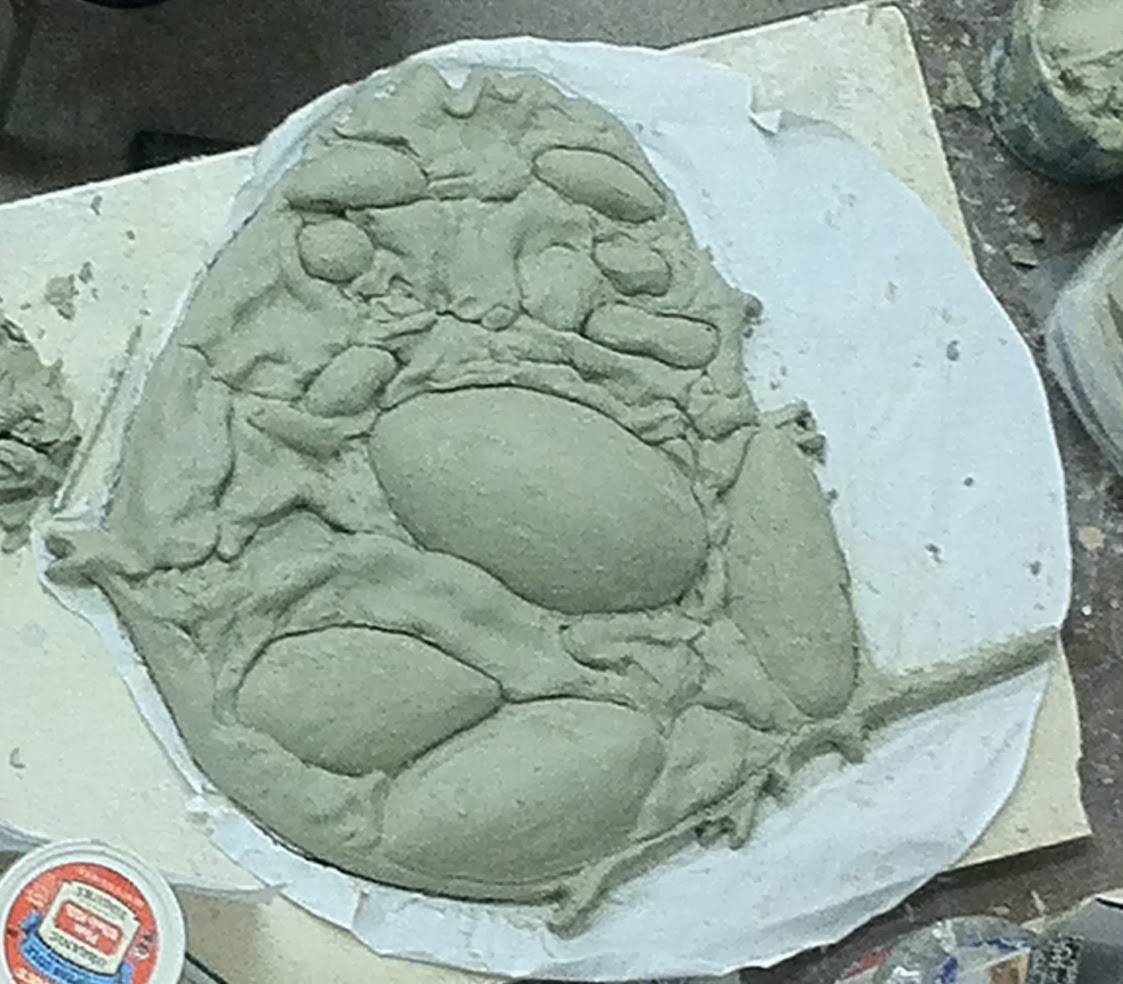Jennifer Brazelton: Essential
Structures
I juxtapose the macro and
the micro to highlight visual parallels and to remind us that we are
structurally connate with the world around us.
Relationships and interdependence are building
blocks for Jennifer Brazelton’s work. Her
intricately constructed ceramic forms re-present and abstract our daily
environment. Using extrusions and pressmolds to generate mass-produced parts,
she arranges multiple elements in layered, formal relationships. The work is simultaneously apprehended as
convoluted highway ramps and as Petri dishes.
Our human point of view oscillates wildly. Are we inside it or outside
it? Governed by it or controlling it?
Brazelton
describes herself an abstract artist. To abstract is to summarize, express a
quality greater than individual elements; to look at ideas. But how do we look
at an idea? In our increasingly sophisticated world, bombarded with visual
signals, Brazelton’s approach utilizes common practice. The artist employs
abstraction by visual blurring between very large and very small points of
view. Repeating patterns - bacterial colonies or farm fields - show an
arrangement of orderly elements whose purpose includes generation, protection
and nurture. Brazelton reduces these
components to reveal essential elements of the governing structure.
Her inspiration comes from visual patterns as
apparently unlike as maps of San Francisco bus lines, viral colony growth
patterns, or machine gears. Patterns of the urban environment contribute to her
organizing principles of visual composition. The mechanical formations hide the
hand of the artist. What is revealed is the mind of the artist.
This intensive investigation
began during graduate study at San Francisco State University. For her thesis exhibition, Brazelton took the
view from a plane as her point of departure, creating scaled landscapes of
fields and cities as seen from the sky. Relationships of size and space,
especially hidden aspects, change with distance. The abstracted perspective
which allowed new visual relationships to emerge intrigued the artist, who
says, “Long airline flights provided
inspiration in the ever-changing landscapes…layered over each other. Rivers and roads became branching trees,
human veins, and knots of rope.”
Brazelton’s highly
thoughtful work includes installation and social practice, such as Pieces of What, a large-format work
recently exhibited at the Richmond Art Center. The wall-mounted piece is a
complex pattern of circular blue forms, with irregular interiors in formal
shapes suggesting a labyrinth. Viewers experienced a focusing of vision, from
the large view across the gallery to face-to-face inspection of color and
texture of individual components. Brazelton says: ”Color for me expresses emotion/ texture can suggest many
things simultaneously.” The composition evokes a map, with implied movement, pathways and
destinations, and the dissected tubular forms reference the human lymph system,
called a transport system in
medicine.
The Lamentations
series critiques the American practice of war as business. War has changed very
little for soldiers at the human level, even as weaponry has moved from stones
to smart bombs. This is the aspect that Brazelton addresses. What is war? is it
the nightly news? The body count, which was dinnertime viewing fare during the
Vietnam era? Lamentations: Growing
American Culture resembles a giant sunflower. Very close reading reveals
that the ‘seeds’ are hundreds of tiny heads of soldiers in helmets. The generic
little heads call up our tepid reaction to the newspapers listing their deaths,
where each face receives one square inch of newsprint in a format as ultimately
anonymous as Brazelton’s minute castings.
Brazelton’s
Neighborhood series looks at the
gated community concept in terms of organic generation and protection. Much
map-based art uses the original cartography, altered but still inherently
familiar at a casual read. Brazelton further abstracts this, remaking the world
in terms of the connection between a baby’s head and an electronic
gatepost.
Neighborhood: Crossroads is an attenuated oval shape
with three swelling apertures, symmetrically placed around a saw-toothed red
form. The color of the red form, its shape and the texture of the wet red glaze
all evoke organic growth. Small spurs on the edge of the red form reveal
themselves, on close reading, as baby heads. They are slick and mottled with
red, like newborns. At the core of these
implied lives is the nurture and
protection of the babies inside the gates.
Very real human conditions drive families to choose survival and
guaranteed protection through such exclusivity. Today’s most exclusive retreat
in the world is found in the manufactured islands near Singapore, quite
literally a world of one’s own, which is what Brazelton asks us to consider.
Aerial views of these new constructions bear an uncanny resemblance to
Brazelton’s clay communities.
Brazelton’s process, like the work she creates, is
an intricate layering of intimate and monumental structure, fused into a new
entity. She says “My
creative process is about absorbing and filtering ideas and information.”
It
is important to the artist that the works are beautiful, and that they meet
exacting standards of technical construction and formal composition. In order for the close relationships between
macro and micro structures to prove out, they must be accurately made. The
necessity for getting all the details right at this level makes Brazelton a
meticulous worker. Although her careful attention to detail is thorough and
considered, she remains open to spontaneous evolution, and the clay contributes
its unique unpredictability:
“I love the unknown element, especially the results of kiln firings. You
might think you know what is going to happen, but often it is not what you
expected. This can be both good and bad.”
Brazelton
uses abstraction to reveal hidden structures stripped of nonessential elements.
Engaging her detailed work is provocative, as we are called upon to exchange
casual perception for a thorough awareness of how closely enmeshed we really
are. To be connate can indicate that dissimilar elements are forced together.
The layers of such connate structures vary extremely: water in rock, charged
ions in soap, soldiers at war. The protected family inside an exclusive
community is also confined there, linked through social expectation and
practice. Brazelton’s ceramic works
locate and examine these hidden relationships, creating a fascinating new
lexicon.
Jennifer Brazelton’s
work is exhibited nationally and appears in numerous publications. She maintains her studio at the Voulkos Dome
complex in Oakland and teaches at California State University, East Bay,
Merritt College, Ohlone College, and San Francisco State University. Brazelton
lives with her husband, artist Tom Michelson, in San Francisco.
Susannah Israel is a
well-known artist, writer and educator living in East Oakland. www.SusannahIsrael.net






























